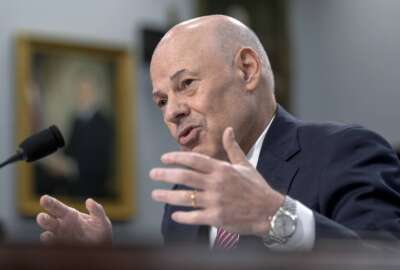How AmeriCorps hopes to recruit more seniors
"We have about 140,000 volunteers that volunteer through our grantees. We have grantees in every state and two territories," said Atalaya Sergi.
AmeriCorps has completed an overhaul of rules and regulations for its seniors program. It aims top make it easier for seniors to join up. Here with the details on the Federal Drive with Tom Temin, the director of AmeriCorps Seniors, Atalaya Sergi.
Interview transcript:
Tom Temin And let’s begin with the seniors program itself. Tell us what it’s all about, where it fits in with AmeriCorps mission. I think a lot of people sometimes forget AmeriCorps is a federal agency in the first place.
Atalaya Sergi AmeriCorps, the federal agency. Our mission is to improve lives, strengthen communities and fosters civic engagement through service and volunteering. And so that is our task for the nation. And AmeriCorps Seniors is an office within the agency that focuses on engaging older adults. So adults 55 years of age or more in national service in their communities. We seek to keep them engaged, to bring all of the lived experience, their knowledge, their skills and talents to the community so that they can continue to make their communities a rich place to live.
Tom Temin And what are the types of things they actually do in those communities?
Atalaya Sergi We have four programs. Our three signature programs, the first one is the Foster Grandparent program. So that one partners older adult volunteers with children and youth helping them with their academic and social emotional development. So the volunteers are tutors and mentors. Then we have the Senior Companion program where the volunteers help other older adults or those who are living with disabilities to remain in their homes and live independently as long as they can. And they also give respite support to caregivers. And then our third signature program is RSVP. And that program kind of becomes the face of their community. So the grantees who have grants, they decide what is the thing in their community that they need to focus on. And they recruit volunteers to do that work. So RSVP does everything from food security to supporting people with their taxes to supporting veterans and military families and everything in between. Right now, we probably have a lot of our RSVP volunteers doing disaster support in the places that have been impacted recently. And then our fourth program is a smaller program. It doesn’t get a lot of press, because it’s really an opportunity to test new things, test new ways of engaging older adults in service and new ways of supporting older adults. It’s called the Senior Demonstration program. And right now we have two senior demonstration opportunities that have grantees working in them. One is focused on using a service as a pathway back to employment for older adults that are interested in going back into the workforce or changing careers. And then the other one is partnering with our native nations and indigenous communities to develop programing that is more in alignment with their cultural practices and the norms of their nations. So those are our programs.
Tom Temin All right. And with the millions and millions of boomers and many of whom are complaining, I don’t know what I’m going to do when I retire, I would think you’d have millions of people pounding on the doors.
Atalaya Sergi We have about 140,000 volunteers that volunteer through our grantees. We have grantees in every state and two territories. Organizations that get our grants are nonprofits, faith based nonprofits, tribal nations, local government agencies can get our grants. And so we have about 900 plus, almost a thousand grantees that are supporting these hundred and 40,000 volunteers to work in their communities.
Tom Temin We’re speaking with Atalaya Sergi. She’s director of AmeriCorps Seniors. And let’s get to the part about changing the rules. You went through an extensive rulemaking that is now finalized. What were you trying to accomplish with the change in rules?
Atalaya Sergi What we wanted to do with the changes in our rules was to remove barriers for individuals to serve in AmeriCorps. Seniors, help make it more streamlined for individuals to come and volunteer. And also supporting our grantees to make things a little bit more flexible for them, for them to be able to really be responsive to their local community needs and the unique needs that they have with some of the changes in our volunteers and also removing administrative burden where we can so that they can really be focused on the work in their communities and supporting their volunteers to do that.
Tom Temin And what do you feel were the main barriers? There’s one, for example, about a modernized income calculation. What’s that all about?
Atalaya Sergi We wanted to look at how the income for our foster grandparent and senior companion programs was calculated. So to be a volunteer in foster grandparent senior companion, and to receive the modest $4 service hour stipend, you have to be within 200% of poverty. And so the whole focus for those programs is also to engage older adults that have lower incomes and remove the cost of volunteering so that they can participate and they can be engaged in community. And so when we looked at some of the things that were in the calculation of income, and mind you, foster grandparents was our very first program that started in 1965, Senior Companions was in 1974.
Tom Temin So the first three recipients are grandparents now.
Atalaya Sergi Yes. So those programs still have things that were from those times in some of the rules that we were looking at. And so for income calculation, we noticed that there were some things in the calculation that were not mandated or required income. They were very subjective. So it was things like income that you might receive from a family member. Well, we all know that even in my own family, yes. We as children and grandchildren, we sometimes provide our parents with some extra funds here and there for things that they want to do. But it’s very dependent upon whether we have extra money that particular month. And so because this income really ties back to whether someone can participate in the program or not, we didn’t want to just have things that were not mandated, not permanent. We didn’t want temporary things to be impacting someone’s ability to participate, because maybe over the last two months, your daughter has been able to give you extra funds. But that’s not true every month.
Tom Temin Sure. Is it possible for someone to volunteer and forego the stipend because they have means and they just want to help?
Atalaya Sergi For the Foster Grandparent Senior Companion program, about 10% of any grantees a volunteer pool can be those that are over the income. Because we do want to keep that open. We want to have that open to those that can. But because those programs were also designed specifically to engage volunteers who had lower incomes and make it possible for them to volunteer, we try to keep that 90% of volunteers, those that have the lower incomes.
Tom Temin And then you have also changed the rules in match requirements for the grantees. It looks like.
Atalaya Sergi We changed it for the RSVP program. So the RSVP program had a match requirement that changed each year up until the third year. And the foster grandparent and senior companion programs had a flat 10%. That never changed, no matter how long you had your grant. And so we wanted to bring some consistency across our portfolio. One, we didn’t want to treat the programs differently, so we wanted to bring RSVP down to that 10%. That is also one of the things that was a streamlining of administrative work as well. So a program would know over the course of your grant, your match is always going to be 10%. So that meant that they could plan each year a little bit better in order to raise the funds or raise the match that they needed to contribute to their program. So it did two things, it also it took a little bit of financial stress off of those programs so that they could be sustainable over time and also reduce some of the administrative burden, which then allows our programs to really focus on the recruitment and retention of their volunteers. We lost a lot of volunteers through the pandemic, and our programs are still building up their volunteer basis back to where they were pre-pandemic. And so this is also an opportunity for them to really focus on that work. And RSVP is our largest program of the three as well.
Tom Temin And you have really two ways to look at this. One, there are people in affluent areas who are low income nevertheless, but the organizations that get the grants probably are pretty well equipped financially. And then you have areas that are impoverished, Lehigh Valley in Pennsylvania or Northwest part of Arizona, whatever the case might be, where the grantee organizations may themselves be kind of hard up for funds. And so how do you look at it that way?
Atalaya Sergi So most of our grantees in AmeriCorps seniors tend to be smaller local organizations. We do have some that are funded, supported also by their states and that kind of thing. But they tend to be smaller local organizations. That is kind of the DNA of AmeriCorps seniors. We fund local organizations to recruit older adults that live in those communities to continue to serve those communities. So one of the things that we had noticed, and I think is true of many nonprofits at the time, is that fundraising is a lot harder. And we didn’t want the grantees who were doing wonderful work in the community, engaging volunteers to have to relinquish or give up their grants because of the financial burden. And so this was one of the ways that we could do multiple things at the same time in support of our grantees, bringing some equity across our portfolio, also allowing them to really focus on service to community.
Tom Temin And you mentioned 140,000 individuals participate in around 1,000 grantees. What would you like to see it say in two years from now?
Atalaya Sergi In two years from now, I would hope that we could get maybe back to 200,000 volunteers just in AmeriCorps seniors. Right now, the agency has about 200 to 200,000 volunteers. 140 of those are in AmeriCorps seniors. I would hope that we could get AmeriCorps seniors up to just 200,000 volunteers and increasing our number of grantees to that or having our grantees that we have. You’re bringing in some new grantees, but also having the ones we have grow and serve more of their community and be able to bring in more volunteers.
Copyright © 2024 Federal News Network. All rights reserved. This website is not intended for users located within the European Economic Area.
Tom Temin is host of the Federal Drive and has been providing insight on federal technology and management issues for more than 30 years.
Follow @tteminWFED






